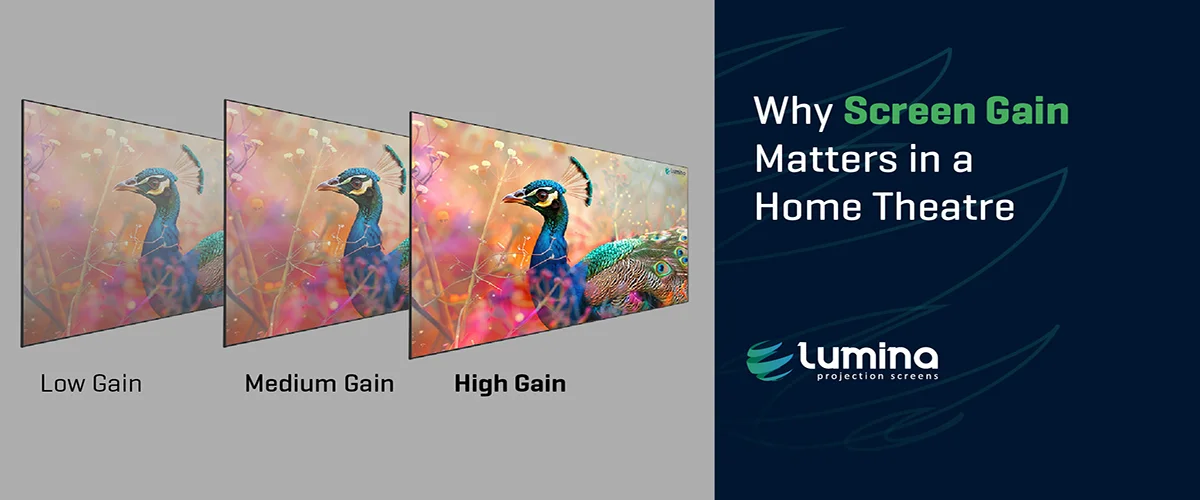
In setting up a home theatre, many people focus on the projector. However, the projection screen plays a significant role in delivering high-quality visuals. One crucial factor to understand is screen gain—the measure of how much light a screen reflects. Choosing the right screen gain can significantly impact your home theatre’s overall performance.
I. What is Screen Gain?
Screen gain measures the amount of light a screen reflects compared to a standard whiteboard, which has a gain of 1.0. A screen with higher gain reflects more light and results in a brighter image, while lower gain screens offer a more even and softer reflection. Here’s a breakdown:
- Gain of 1.0: Reflects light evenly, making it ideal for most home theatres.
- Higher gain (1.2 – 1.5): Increases brightness, perfect for rooms with some ambient light.
- Lower gain (<1.0): Provides wide viewing angles and accurate color reproduction but may produce a dimmer image.
II. How Screen Gain Affects Viewing Experience
- Image Brightness
The main role of screen gain is to determine the image’s brightness. High-gain screens, like Lumina’s Leor 1.5, are perfect for rooms with uncontrolled ambient light. They amplify the projector’s brightness, allowing for vivid images even in bright conditions. - Viewing Angles
High-gain screens often focus light toward the center of the room, meaning that viewers sitting at an angle may experience dimmer images. On the other hand, lower-gain screens like Leor Black offer wider viewing angles, ensuring that everyone in the room enjoys the same image quality. - Contrast and Color Accuracy
High-gain screens improve brightness but can affect contrast and color accuracy. Lower-gain screens like Leor Black excel at maintaining contrast and providing deeper black levels, especially in darker rooms, for a more cinematic experience.
III. Choosing the Right Screen Gain for Your Space
- Room Size and Viewing Distance
For smaller rooms with ambient lighting, a low-gain screen like Leor Black is ideal. Its 90% ambient light rejection ensures contrast and color fidelity, making it a top choice for dedicated home theatre setups.
In larger rooms, Leor 1.5 offers enhanced brightness and deeper black levels, making it ideal for living rooms or spaces where lighting cannot be controlled. - Lighting Conditions
For rooms with windows or bright light sources, Lumina’s entire Leor series, featuring advanced Ambient Light Rejecting (ALR) technology, is an ideal choice. These screens, including options like Leor UST and Leor Black, effectively block ambient light from various angles, ensuring bright, clear images even in well-lit spaces. - Projector Brightness
Pair your screen with the right projector. Low-gain screens like Leor Black are suitable for bright projectors, while high-gain screens like Leor 1.5 can help boost the image quality of projectors with lower brightness.
IV. Benefits of High-Quality Screens with the Right Gain
Choosing the correct screen gain can greatly enhance your home theatre experience.
- Leor Black provides superior contrast and color accuracy, ideal for rooms with ambient light.
- Leor 1.5 offers bright, immersive visuals.
- Leor UST uses advanced technology to reject ambient light from above and perpendicular to the screen, perfect for short-throw projectors in well-lit rooms.
With Lumina Screens range of products, you can balance gain, contrast, and brightness, ensuring the best possible viewing experience.
Screen gain matters because it affects brightness, contrast, and viewing angles. By considering your room’s lighting, size, and projector, you can choose the right Lumina screen for your home theatre setup. Explore Lumina Screens to find the perfect screen for your entertainment needs.
FAQ’s
What is screen gain?
Screen gain measures the screen’s reflectivity. Higher gain screens reflect more light, ideal for bright environments, while lower gain offers wider viewing angles.
What is screen gain in a home theatre?
Screen gain measures how much light a projection screen reflects compared to a standard whiteboard (gain of 1.0). Higher gain screens reflect more light, resulting in brighter images, while lower gain screens offer wider viewing angles and better color accuracy.
How does screen gain affect image brightness?
Higher gain screens increase image brightness, making them suitable for rooms with ambient light. Lower gain screens may produce dimmer images but provide more uniform brightness across wider viewing angles.
What screen gain is ideal for rooms with ambient light?
For rooms with ambient light, screens with higher gain (e.g., 1.2 to 1.5) are recommended as they enhance image brightness. Additionally, screens with Ambient Light Rejecting (ALR) technology, like Lumina’s Leor series, effectively block ambient light, ensuring clear images.
How does screen gain influence viewing angles?
High-gain screens tend to direct light towards the center, potentially causing dimmer images for viewers at wider angles. Low-gain screens provide consistent brightness and color accuracy across a broader range of viewing positions.
Which Lumina screen is best for a dedicated home theatre setup?
Lumina’s Leor Black screen, with its 90% ambient light rejection and lower gain, is ideal for dedicated home theatre setups, offering superior contrast and color fidelity.
What is the best projector screen for a small home theater room?
A screen with a 16:9 aspect ratio and a diagonal size of 80–100 inches is ideal for small rooms. Consider an ALR or grey screen for better contrast in mixed lighting.
How does screen grain affect picture quality?
Screen grain refers to the texture of the screen surface. A smoother surface delivers sharper images, while textured screens may scatter light, reducing clarity.
Do I need a special screen for 4K projectors?
Yes, using a high-resolution screen with finer textures ensures you get the full clarity and detail of 4K content.
Are grey screens better for watching movies during the day?
Yes, grey screens enhance contrast and black levels, making them suitable for daytime viewing with moderate ambient light.
- Date - October 28, 2024